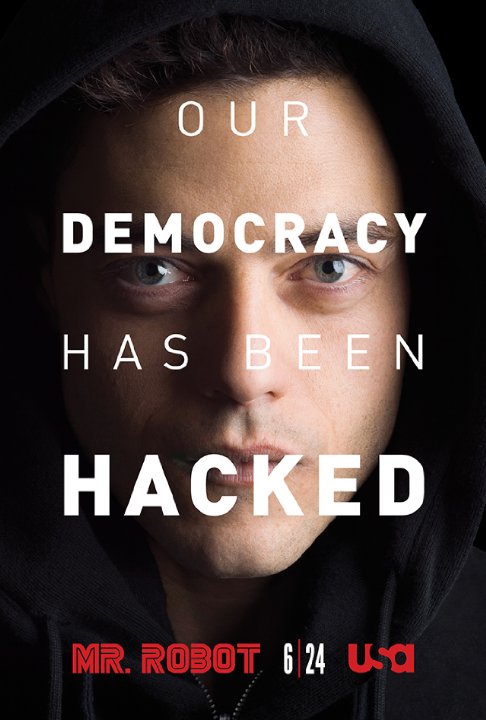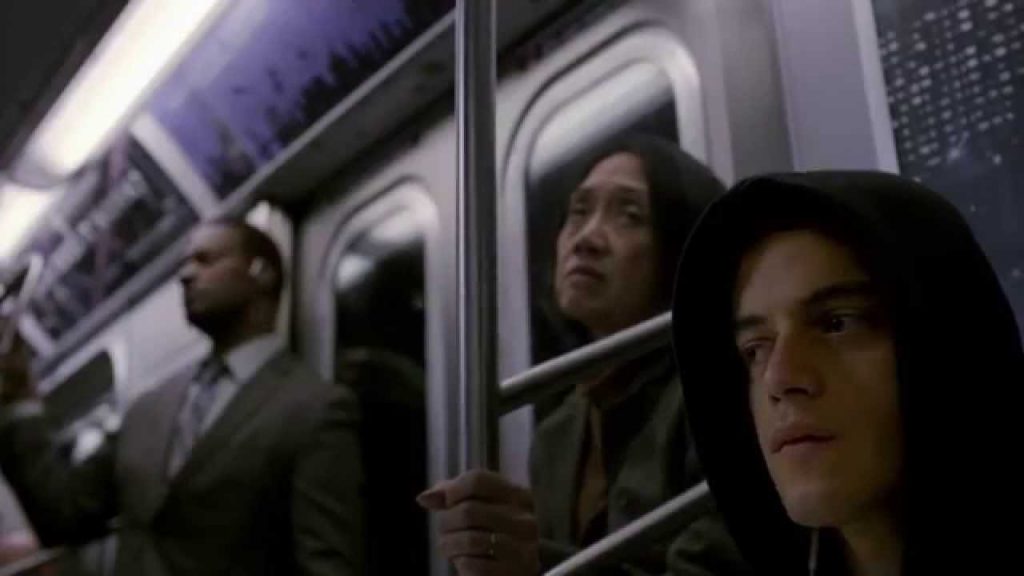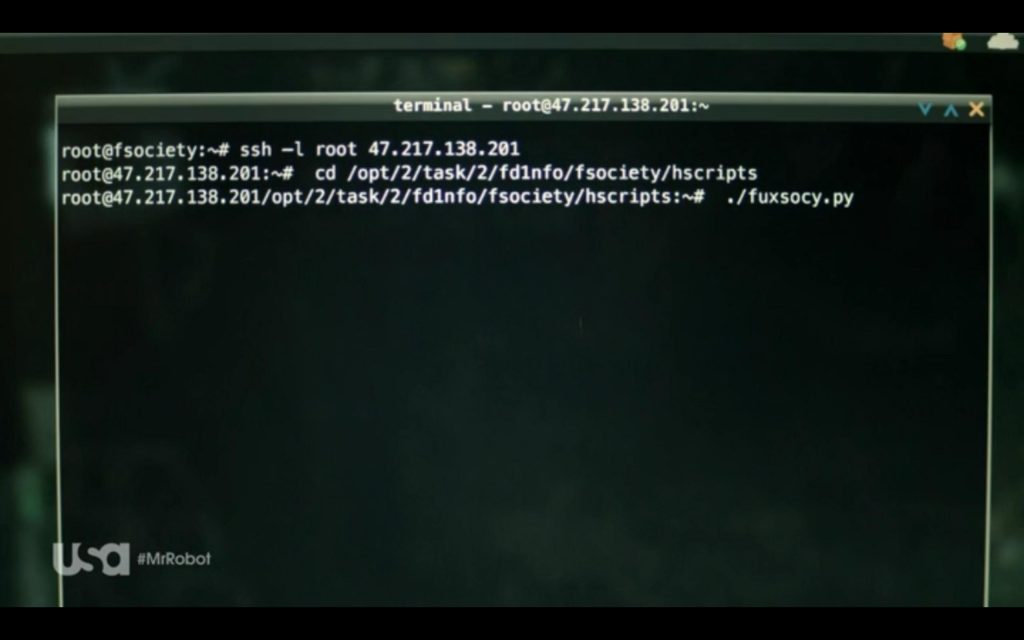Jason recommends: “Mr. Robot”
 This is just a note to let you know that you should be watching USA Network’s Mr. Robot, because it is quickly establishing itself as the best new show of the year.
This is just a note to let you know that you should be watching USA Network’s Mr. Robot, because it is quickly establishing itself as the best new show of the year.
In Mr. Robot, Rami Malek plays Elliot Alderson, a brilliant but troubled young cybersecurity engineer. He makes his living helping giant corporations secure their networks against intrusions by hackers. When he looks at the clients he works for, however, he wonders if he’s on the right side of that particular war. One in particular, an enormous conglomerate called E Corp seems to him to encapsulate everything that’s wrong with modern society, where huge, unaccountable business interests exploit peoples’ hopes, fears and desires from the day they are born until the day they die. (Whenever E Corp’s name is spoken, Elliot mentally corrects it to “Evil Corp.”)
Then one day Evil Corp’s network is hacked, and while racing to contain the damage, Elliot makes a discovery. Tucked away in a server on Evil Corp’s network is a file written specifically for him. It leads him to a gruff, scruffy older man (played by Christian Slater) in a worn computer repairman’s overalls with a name tag that reads “Mr. Robot.”
Mr. Robot, it emerges, is the leader of a loose confederation of hackers that call themselves “Fsociety.” And Fsociety wants Elliot to join them, to switch sides and help them pull off an audacious hack. Through its subsidiaries, Mr. Robot explains, Evil Corp holds the debt of millions of people: mortgages, student loans, credit cards, and so forth. This is the lever it uses to keep those people in line. And Fsociety wants to erase it. Erase it all. Burn all the records and set the debtors free.
For Elliot, this is the call to action he’s been waiting his whole life for; he joins Fsociety, and starts helping them work out how to turn their vision into reality. But things start to go wrong almost immediately, and the first season is emerging as as a story of unintended consequences, as Elliot’s actions start a chain of dominoes tumbling over that’s much longer than he’d imagined. And as he watches the dominos fall, he realizes to his mounting horror that some of them are his friends.
https://www.youtube.com/watch?v=Ug4fRXGyIak
As a premise, this probably doesn’t sound all that revolutionary. And to be honest, it isn’t: the first couple of episodes wear their influences on their sleeves. It’s The Matrix (brilliant programmer is recruited by shadowy resistance organization to Fight The Power™) meets Fight Club (withdrawn, hesitant loner is teased out of his shell to start a revolution that spirals out of control). Watching the pilot, I was dismayed a little by how derivative the show’s aspirations seemed to be.
But we’re five episodes into the first season now, and Mr. Robot has roared away from its pedestrian beginnings to become riveting television. There are a few factors that have driven this. The first is a set of great performances, led by Rami Malek. I’d never heard of Malek before watching Mr. Robot, but he’s now on my (short) list of must-watch actors; with his gaunt, haunted eyes and taut, intense body language, he’s like a younger version of the great Michael Shannon. Malek works hard to establish Elliot as a believable character rather than a caricature of J. Random Hacker, and the work pays off in spades. He’s backed up by a strong supporting cast as well, particularly Frankie Shaw as Elliot’s drug-dealer-slash-maybe-kinda-girlfriend Shayna and Martin Wallström as Tyrell Wellick, an up-and-coming tech exec at Evil Corp who sees Elliot as a tool he can use to speed his ascent up the corporate ladder.
Second, Mr. Robot has a visual style that approaches the cinematic. It has a distinct visual aesthetic that helps tell the story on its own. It’s cool, detached, all wide shots and muted colors. We frequently see characters react to something in a bottom corner of the screen, with the rest of the frame being empty, nothing but background; this very effectively establishes their emotional distance from each other, and from the viewer.
Like Elliot himself, Mr. Robot‘s camera doesn’t let itself get too close to people. Close-ups are powerful things, and Mr. Robot distrusts that power. It wants us to have to struggle a bit to relate to the people it’s showing us.
Finally, unlike nearly every other show about computers and hackers and etc., Mr. Robot cares enough to at least attempt to get the details right. There’s no Independence Day-style “UPLOADING VIRUS” dialog boxes here, no NCIS-style “two idiots, one keyboard” techno-gobbledygook. The technology in Mr. Robot is grounded in reality; it’s Raspberry Pis and SSH sessions in terminal windows.
Most notably, Mr. Robot understands something fundamental about the real world of hacking that few depictions of hackers do: that what successful hackers are hacking isn’t really the technology, but the people who use the technology. In other words, the way you get into a system isn’t by breaking the door down; it’s by convincing a person on the other side of the door to let you walk through it.
Put all these things together, and you get a show that’s started strong and keeps getting stronger with each new episode. You really should be watching, even if you couldn’t care a fig about computers. But don’t take my word for it:
- Vox: “Mr. Robot actually does everything that True Detective pretends to do”
- The New York Times: “Elliot is a little like a computer-age version of Travis Bickle from Taxi Driver, a loner who is paranoid — even about his own sanity“
- The Hollywood Reporter: “The series is ridiculous in description and enthralling in execution because of Malek’s natural charisma and his way with creator and head writer Sam Esmail’s frequent jeremiads against the powerful and moneyed“
- Entertainment Weekly: “Mr. Robot is a worldview-challenging psychological thriller that’s steeped in new-century punk politics, nervy with digital-age anxiety, and made with slick, smart panache“
- Variety: “Mr. Robot feels like a daring risk — one that’s more calibrated to the confines of pay cable, and animated by a welcome spark of inspiration“
So what are you waiting for? Get to watching!


